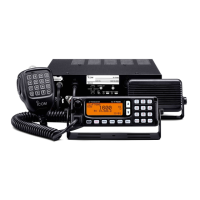4 - 1
SECTION 4 CIRCUIT DESCRIPTION
4-1 RECEIVER CIRCUITS
4-1-1 RF FILTER CIRCUIT (PLL AND MAIN UNITS)
Received signals from the antenna connector are applied
to the transmit/receive switching and protection relay (PLL
unit; RL7301) which is controlled by the CPU via the “TRXS”
line. The signals pass through the 30 MHz cut-off low-pass
filter (PLL unit; L7321, C7321–C7323, C7325), and then
applied to the MAIN unit via the J7321.
The signals pass through the 1.6 MHz cut off high-pass
filter (MAIN unit; L51–L54, L57, C54, C56, C57, C59, C61–
C64, C69) and transmit/receive switch (D54), and are then
applied to one of the bandpass filters (including one low-
pass filter for below 2.0 MHz). These filters are selected by
the filter control signals (B0–B8) as described in the table
below.
The filtered signals are applied to the pre-amplifier (MAIN
unit; Q102, Q103), and then passed through the 33 MHz
cut-off low-pass filter (L202, L203, C202–C206). The
filtered signals pass through the low-pass filter (MAIN unit;
L202, L203, C202–C206), and are then applied to the 1st
mixer circuit (Q201, Q202, Q204, Q205).
4-1-2 1ST MIXER AND IF CIRCUITS (MAIN UNIT)
The 1st mixer circuit converts the received signals into a
fixed frequency, 64.445 kHz 1st IF signal using PLL output
frequency. By changing the PLL frequency, only the desired
frequency is picked up at the 64.445 kHz bandpass filter
(FI201) at the next stage.
The IF amplifier (Q203) and resonator circuits are designed
between the filter pair. The PLL output signal (1LO) enters
the MAIN unit via the J601 and is amplified at the 1st LO
amplifier (Q601). The amplified signal is passed through the
100 MHz cut-off low-pass filter (L602–L604, C602, C604–
C607, C609) to suppress harmonic components, and then
applied to the 1st mixer circuit (Q201, Q202, Q204, Q205).
4-1-3 2ND MIXER AND IF CIRCUITS (MAIN UNIT)
The 1st IF signal from the bandpass filter (FI201) is
converted again into a 455 kHz 2nd IF signal at the 2nd
mixer circuit (D303, L303, L304). The 2nd LO signal (2LO)
from the PLL unit enters the MAIN unit via the J301 to be
applied to the 2nd mixer circuit.
4-1-4 3RD MIXER AND IF CIRCUITS (MAIN UNIT)
The 2nd IF signal passes through the low-pass
filter (L305, C308, C310, C311, C315), and is then
applied to the IF amplifier (Q401) via the ceramic
bandpass filter (FI401). The amplified signal passes
through the other ceramic bandpass filter (FI402),
and then applied to the 3rd mixer circuit via the IF
amplifier (Q501). The 2nd IF signal is converted into a
12 kHz 3rd IF signal at the 3rd mixer circuit (IC501). The
3rd LO signal (3LO) from the PLL unit enters the MAIN unit
via the J3601 to be applied to the 3rd mixer circuit.
• RECEIVER CONSTRUCTION
Frequency (MHz)
0.5–1.9999
2.0–2.4999
2.5–2.9999
3.0–3.4999
3.5–4.9999
5.0–5.4999
5.5–6.9999
7.0–8.9999
9.0–9.9999
10.0–13.9999
14.0–14.9999
15.0–17.9999
18.0–23.9999
24.0–29.9999
BPF ctrl signal
B0
B1
B2
B3
B4
B5
B6
B7
B8
LPF ctrl signal
L1M
L2M
L4M
L6M
L12M
L22M
LPF
Antenna
PLL unit
to transmit/receiver switch
LPF
FI201 FI401
FI402
Q401
Q5013rd mixer
IC501
IC1002
1st mixer
Q201
Q202
Q203
Q204
2nd mixer
D303
1st LO
64 94 MHz
BPF
2 30 MHz
0.5 1.9999 MHz
BPF
Crystal
BPF
Crystal
IF
amp.
BPF
Crystal
LPF
IF
amp.
IF
amp.
DSP
UNIT
2nd LO
64 MHz
3rd LO
443 kHz

